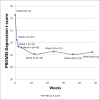The Relationship Between Psychological Symptoms and Ventricular Assist Device Implantation
- PMID: 28807706
- PMCID: PMC5705533
- DOI: 10.1016/j.jpainsymman.2017.05.002
The Relationship Between Psychological Symptoms and Ventricular Assist Device Implantation
Abstract
Context: Ventricular assist devices (VADs) improve quality of life in advanced heart failure patients, but there are little data exploring psychological symptoms in this population.
Objective: This study examined the prevalence of psychiatric symptoms and disease over time in VAD patients.
Methods: This prospective multicenter cohort study enrolled patients immediately before or after VAD implant and followed them up to 48 weeks. Depression and anxiety were assessed with Patient-Reported Outcomes Measurement Information System Short Form 8a questionnaires. The panic disorder, acute stress disorder (ASD) and post-traumatic stress disorder (PTSD) modules of the Structured Clinical Interview for the DSM were used.
Results: Eighty-seven patients were enrolled. After implant, depression and anxiety scores decreased significantly over time (P = 0.03 and P < 0.001, respectively). Two patients met criteria for panic disorder early after implantation, but symptoms resolved over time. None met criteria for ASD or PTSD.
Conclusions: Our study suggests VADs do not cause serious psychological harms and may have a positive impact on depression and anxiety. Furthermore, VADs did not induce PTSD, panic disorder, or ASD in this cohort.
Keywords: Ventricular assist device; anxiety; depression.
Copyright © 2017 American Academy of Hospice and Palliative Medicine. Published by Elsevier Inc. All rights reserved.
Figures



Similar articles
-
Reduced Anxiety and Depression in Patients With Advanced Heart Failure After Left Ventricular Assist Device Implantation.Psychosomatics. 2017 Jul-Aug;58(4):406-414. doi: 10.1016/j.psym.2017.02.001. Epub 2017 Feb 12. Psychosomatics. 2017. PMID: 28408037
-
Mental health status of patients with mechanical aortic valves, with ventricular assist devices and after heart transplantation.Interact Cardiovasc Thorac Surg. 2016 Aug;23(2):321-5. doi: 10.1093/icvts/ivw111. Epub 2016 May 5. Interact Cardiovasc Thorac Surg. 2016. PMID: 27154327
-
Psychiatric evaluation of children and adolescents with left ventricular assist devices.Psychosom Med. 2012 Jun;74(5):554-8. doi: 10.1097/PSY.0b013e318258853a. Psychosom Med. 2012. PMID: 22685244
-
How does successful bridging with ventricular assist device affect cardiac transplantation outcome?Interact Cardiovasc Thorac Surg. 2011 Oct;13(4):405-9. doi: 10.1510/icvts.2011.273722. Epub 2011 Jul 25. Interact Cardiovasc Thorac Surg. 2011. PMID: 21788304 Review.
-
[Posttraumatic stress disorder (PTSD) as a consequence of the interaction between an individual genetic susceptibility, a traumatogenic event and a social context].Encephale. 2012 Oct;38(5):373-80. doi: 10.1016/j.encep.2011.12.003. Epub 2012 Jan 24. Encephale. 2012. PMID: 23062450 Review. French.
Cited by
-
Depression among Patients with an Implanted Left Ventricular Assist Device: Uncovering Pathophysiological Mechanisms and Implications for Patient Care.Int J Mol Sci. 2023 Jul 10;24(14):11270. doi: 10.3390/ijms241411270. Int J Mol Sci. 2023. PMID: 37511030 Free PMC article. Review.
-
Comparing mental health and substance use disorders in patients receiving durable VADs versus transplants: A TriNetX database analysis.Int J Artif Organs. 2025 Jan;48(1):15-22. doi: 10.1177/03913988241305309. Epub 2024 Dec 26. Int J Artif Organs. 2025. PMID: 39726069 Free PMC article.
-
Heart Transplantation and Left Ventricular Assist Devices: Long-Term Prognosis and Effects on Mental Health.Cureus. 2024 Sep 5;16(9):e68691. doi: 10.7759/cureus.68691. eCollection 2024 Sep. Cureus. 2024. PMID: 39371854 Free PMC article. Review.
-
Mental Health and Substance Use Disorders in Transplant Waitlist, VAD, and Heart Transplant Patients: A TriNetX Database Analysis.J Clin Med. 2024 May 28;13(11):3151. doi: 10.3390/jcm13113151. J Clin Med. 2024. PMID: 38892862 Free PMC article.
-
Psychological Spectrum Experienced by Heart Failure Patients After Left Ventricular Assist Device Implantation.Cureus. 2020 Aug 11;12(8):e9671. doi: 10.7759/cureus.9671. Cureus. 2020. PMID: 32923266 Free PMC article. Review.
References
-
- Kirklin JK, Naftel DC, Pagani FD, et al. J Heart Lung Transplant. Vol. 33. United States: International Society for Heart and Lung Transplantation; 2014. Sixth INTERMACS annual report: A 10,000-patient database; pp. 555–564. All rights reserved. - PubMed
-
- Centers for Medicare & Medicaid Services. Proposed decision memo for ventricular assist devices for bridge-to-transplant and destination therapy (CAG-00432R) Washington D.C.: Centers for Medicare & Medicaid Services; 2013.
Publication types
MeSH terms
Grants and funding
LinkOut - more resources
Full Text Sources
Other Literature Sources
Medical
Miscellaneous

